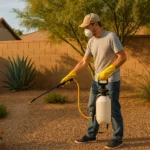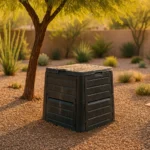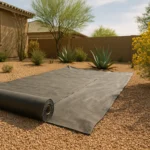Spring brings a burst of life and color to our yards, especially in the vibrant community of Queen Creek, Arizona. It’s the perfect time to get your hands dirty and give your yard the love it deserves. With the right spring yard care techniques, you can transform your space into a lush oasis. In this article, I, Marcus Wynn, will share some insider secrets on how to revitalize your Queen Creek yard this spring.

Understanding the Queen Creek Climate
The first step to successful yard care is understanding your local climate. Queen Creek, located in the Southeast Valley of Phoenix, experiences a desert climate. This means we see high temperatures, low humidity, and minimal rainfall. While challenging, this climate also provides a unique opportunity to cultivate a variety of drought-tolerant plants that can thrive in our harsh summers and mild winters.
The spring season, which extends from March to May in Queen Creek, is an ideal time to rejuvenate your yard. Temperatures start to rise, making it the perfect time to plant and prepare your yard for the scorching summer months. However, keep in mind that the occasional spring frost can occur, so it’s essential to monitor the weather and protect your plants when necessary.
Spring Cleaning Your Yard
Just like our homes, our yards also need a good spring cleaning. This process involves removing any winter debris such as fallen leaves and branches, weeding, and pruning dead or damaged limbs from trees and shrubs. The goal is to clear the way for new growth and prevent any disease or pest problems from escalating.
Another critical aspect of spring cleaning is aerating your lawn. This process involves making small holes in the soil to allow air, water, and nutrients to penetrate the grass roots. It helps the roots grow deeply and produce a stronger, more vigorous lawn. Aeration is best done during the growing season when the grass can heal and fill in any open areas after soil plugs are removed.
Choosing the Right Plants for Your Yard
Choosing the right plants is crucial to creating a lush and dynamic yard. Given Queen Creek’s desert climate, it’s best to opt for native or drought-tolerant plants. Some great options include Desert Marigold, Red Yucca, and Blue Palo Verde. These plants are not only beautiful but also require less water and maintenance, making them perfect for busy homeowners.
When planning your yard, consider the different heights, colors, and blooming times of your chosen plants. This will create visual interest and ensure that something is always blooming in your yard. Remember, a well-planned yard can increase your property’s value and provide a sanctuary for local wildlife.
Regular Watering and Fertilizing
Regular watering and fertilizing are critical components of spring yard care. However, it’s important to strike a balance. Overwatering can lead to root rot and other diseases, while underwatering can result in dry, brown patches. The amount of water your yard needs will depend on the type of plants, the soil, and the weather. Generally, it’s best to water deeply and infrequently to encourage deep root growth.
When it comes to fertilizing, slow-release granular fertilizers are a good choice for spring. They release nutrients over time and typically need to be applied only once during the season. Make sure to choose a fertilizer that is appropriate for your soil and plant types. Remember, too much fertilizer can harm your plants and contribute to water pollution.
Maintaining a Healthy Lawn
Maintaining a healthy lawn is an integral part of yard care. Regular mowing, watering, and fertilizing are key. Make sure to adjust your mower height to the highest setting, as taller grass shades the soil, reducing water evaporation and preventing weed growth. Also, leave the clippings on the lawn after mowing. They will decompose and return valuable nutrients to the soil.
Spring is also the best time to seed any bare spots in your lawn. Use a lawn repair mixture that contains grass seed, lawn food, and a coir mulch that will help keep the seeds moist. Be sure to water the newly seeded areas daily until the grass is well established.
Protecting Your Yard from Pests
Protecting your yard from pests is crucial to maintaining its health and beauty. In Queen Creek, common pests include aphids, beetles, and whiteflies. While some pests can be beneficial, others can cause significant damage to your plants. Regular inspection of your yard can help you spot pest problems early and take action before they get out of hand.
If you do encounter pests, opt for organic or natural pest control methods whenever possible. These methods are less harmful to the environment and safer for children and pets. Some natural pest control options include introducing beneficial insects, using plant-based insecticides, or creating homemade sprays with common household ingredients like dish soap and vinegar.
Final Thoughts
Spring yard care in Queen Creek doesn’t have to be complicated. By understanding our unique climate, choosing the right plants, keeping up with regular maintenance, and being vigilant about pests, you can create a yard that is not only beautiful but also sustainable. Remember, yard care is a year-round task, but the work you do in spring will lay the foundation for a healthy, vibrant yard all year long.






